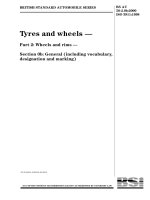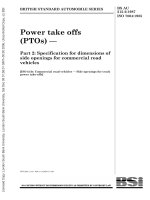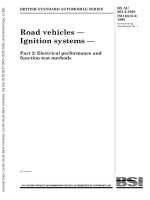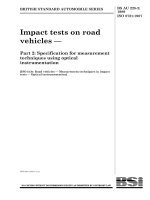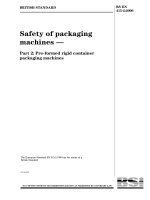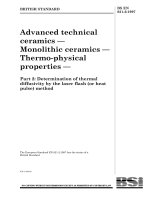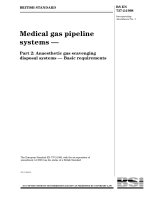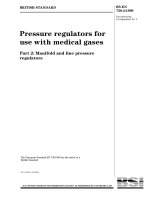Bsi bs en 61143 2 1994 (2000)
Bạn đang xem bản rút gọn của tài liệu. Xem và tải ngay bản đầy đủ của tài liệu tại đây (330.74 KB, 12 trang )
BRITISH STANDARD
BS EN
61143-2:1994
IEC 1143-2:
1992
Incorporating
Amendment No. 1
Specification for
Electrical measuring
instruments —
X-t recorders —
Part 2: Recommended additional test
methods
The European Standard EN 61143-2:1994 has the status of a
British Standard
BS EN 61143-2:1994
Committees responsible for this
British Standard
The preparation of this British Standard was entrusted by the Power Electrical
Engineering Standards Policy Committee (PEL/-) to Technical Committee
PEL/13, upon which the following bodies were represented:
Association of Consulting Engineers
Department of Energy (Electricity Division)
Department of Trade and Industry (National Physical Laboratory)
Electricity Association
The Association for the Instrumentation, Control and Automation Industry
GAMBICA (BEAMA Ltd.)
Institution of Electrical Engineers
Institution of Incorporated Executive Engineers
This British Standard, having
been prepared under the
direction of the Power Electrical
Engineering Standards Policy
Committee, was published
under the authority of the
Standards Board and comes
into effect on
15 March 1993
© BSI 04-2000
The following BSI references
relate to the work on this
standard:
Committee reference PEL/13
Draft for comment 92/25058 DC
ISBN 0 580 21993 3
Amendments issued since publication
Amd. No.
Date
Comments
8389
January
1995
Indicated by a sideline in the margin
BS EN 61143-2:1994
Contents
Page
Committees responsible
Inside front cover
National foreword
ii
Foreword
2
Introduction
3
1.1 Scope
3
2.11 Intrinsic error test
3
2.12 Additional error due to zero displacement
3
2.13 Mutual influence of different measuring circuits of multiple
and multiple channel recorders
4
4.20 Determination of the value of the dead band
4
6
Influence of parasitic quantities
4
6.1 Common mode interference
4
6.2 Series (parallel) mode interference
4
7
Test of dynamic performance
4
7.1 Response time
5
7.2 Frequency response range
5
7.3 Overshoot
5
List of references
Inside back cover
© BSI 04-2000
i
BS EN 61143-2:1994
National foreword
This British Standard has been prepared under the direction of the Power
Electrical Engineering Standards Policy Committee. It is identical with
IEC 1143-2:1992 Electrical measuring instruments — X-t recorders —
Part 2: Recommended additional test methods published by the International
Electrotechnical Commission (IEC).
In 1994 the European Committee for Electrotechnical Standardization
(CENELEC) accepted IEC 1143-2:1992 as European Standard EN 61143-2:1994.
As a consequence of implementing the European Standard this British Standard
is renumbered as BS EN 61143-2 and any reference to BS 7610-2 should be read
as a reference to BS EN 61143-2.
Cross-reference
International Standard
Corresponding British Standard
IEC 51-9
BS 89 Direct acting indicating analogue electrical
measuring instruments and their accessories
Part 9:1990 Recommended test methods
(Identical)
A British Standard does not purport to include all the necessary provisions of a
contract. Users of British Standards are responsible for their correct application.
Compliance with a British Standard does not of itself confer immunity
from legal obligations.
Summary of pages
This document comprises a front cover, an inside front cover, pages i and ii,
the EN title page, pages 2 to 6, an inside back cover and a back cover.
This standard has been updated (see copyright date) and may have had
amendments incorporated. This will be indicated in the amendment table on the
inside front cover.
ii
© BSI 04-2000
EUROPEAN STANDARD
EN 61143-2
NORME EUROPÉENNE
June 1994
EUROPÄISCHE NORM
Supersedes HD 301 S1:1977
ICS 19.080
Descriptors: Measuring instrument, electrical measurement, recorder, X-t recorder, specific tests to X-t recorders
English version
Electrical measuring instruments — X-t recorders
Part 2: Recommended additional test methods
(IEC 1143-2:1992)
Appareils électriques de mesure
Enregistreurs X-t
Partie 2: Méthodes d’essais complémentaires
recommandées
(CEI 1143-2:1992)
Elekrische Meßgeräte
X-t-Schreiber
Teil 2: Empfohlene zusätzliche Prüfverfahren
(IEC 1143-2:1992)
This European Standard was approved by CENELEC on 1994-03-08.
CENELEC members are bound to comply with the CEN/CENELEC Internal
Regulations which stipulate the conditions for giving this European Standard
the status of a national standard without any alteration.
Up-to-date lists and bibliographical references concerning such national
standards may be obtained on application to the Central Secretariat or to any
CENELEC member.
This European Standard exists in three official versions (English, French,
German). A version in any other language made by translation under the
responsibility of a CENELEC member into its own language and notified to the
Central Secretariat has the same status as the official versions.
CENELEC members are the national electrotechnical committees of Austria,
Belgium, Denmark, Finland, France, Germany, Greece, Iceland, Ireland, Italy,
Luxembourg, Netherlands, Norway, Portugal, Spain, Sweden, Switzerland and
United Kingdom.
CENELEC
European Committee for Electrotechnical Standardization
Comité Européen de Normalisation Electrotechnique
Europäisches Komitee für Elektrotechnische Normung
Central Secretariat: rue de Stassart 35, B-1050 Brussels
© 1994 Copyright reserved to CENELEC members
Ref. No. EN 61143-2:1994 E
EN 61143-2:1994
Foreword
The CENELEC questionnaire procedure, performed
for finding out whether or not the International
Standard IEC 1143-2:1992 could be accepted
without textual changes, has shown that no
common modifications were necessary for the
acceptance as European Standard.
The reference document was submitted to the
CENELEC members for formal vote and was
approved by CENELEC as EN 61143-2
on 8 March 1994.
This European Standard replaces HD 301 S1:1977.
The following dates were fixed:
— latest date of publication
of an identical national
standard
— latest date of withdrawal
of conflicting national
standards
2
(dop) 1995-03-15
(dow) 1995-03-15
© BSI 04-2000
EN 61143-2:1994
Introduction
This part of IEC 1143 shall be read in conjunction
with part 1 and IEC 51-9:1988, Direct acting
indicating analogue electrical measuring
instruments and their accessories —
Part 9: Recommended test methods.
It gives details of tests which are specific to X-t
recorders. The testing conditions and the more
conventional tests, which shall be followed, are
those given in the following list of subclauses from
IEC 51-9:
1.2
1.2.8
1.2.9
1.2.11
1.2.12
1.2.13
3.2
3.4
3.5
3.5.2
3.6
3.5.2
3.6
3.7
3.8
3.17
3.18
4.1
4.6
4.10
4.19
Other clauses from IEC 51-9 may also be applied, if
relevant.
For easier reference clause numbering follows that
of IEC 51-9.
For X-t recorders, tapping is not allowed.
In case of doubt, the text of this part 2 as well as that
of part 1 shall prevail.
1.1 Scope
See part 1.
2.11 Intrinsic error test
The recorder shall be under reference conditions
with the auxiliary circuits energized.
2.11.1 Measuring circuit
Before determining the intrinsic error, the record
shall be at the chart scale line corresponding to zero
and the chart driving mechanism shall be on.
The errors shall be determined for both increasing
and decreasing values of the measurand as follows:
This test shall be performed at five approximately
equal steps within the span, including the lower and
upper limits of the measuring range.
For single channel dotted line recorders, the reading
used shall be that of the dot next following the one
indicating that the steady state has been reached.
During this test the chart shall be driven at a
sufficiently high speed for the individual dots to be
distinguishable.
Computation:
The intrinsic error, expressed as a percentage, shall
be computed for each selected step as follows:
Bx – Ba
--------------------- ´ 100
As
where As is the span.
2.11.1.2 For multiple recorders, the determination
of the errors shall be carried out on every measuring
circuit in sequence, the other measuring circuits
being energized so that their record corresponds to
the lower limit of the span.
2.11.1.3 For multiple channel recorders, the
procedure is analogous to that given in 2.11.1.2.
2.11.2 Time-keeping
Procedure:
The recorded time, Tx, is determined from the
values of the chart time lines corresponding to two
abrupt changes in the value of the measurand.
The actual value, Ta, of the time between these
changes shall be measured using a timing device of
sufficient accuracy that any error caused is small
(such as one tenth) compared with the intrinsic
error in time-keeping being determined.
The chart shall have been driven for a sufficient
time before the first abrupt change to have reached
a steady speed and for a distinct change of the
record, as a function of time, to be observed.
Computation:
The intrinsic error in time-keeping, expressed as a
percentage of the actual (true) value of the elapsed
time is:
Tx – Ta
--------------------- ´ 100
Ta
2.11.1.1 Continuous line recorders and single
channel dotted line recorders
2.12 Additional error due to zero
displacement
Procedure:
An input quantity shall be applied and increased
sufficiently slowly, in order to avoid overshoot, to a
value corresponding to the input quantity, Ba. The
recorded value, Bx, shall be read as soon as the
steady state value of the input has been reached and
the chart has advanced by at least 2 mm.
Before the determination of the additional error, the
recorder should be on a chart scale line at
approximately 10 % of the span and the chart
driving mechanism on. The zero displacement shall
be off. Note the recorded value, Ba, after the chart
has been driven for 5 s or approximately 2 mm
whichever is the greater.
© BSI 04-2000
3
EN 61143-2:1994
Procedure
Switch on the zero displacement and apply an input
quantity, Az, corresponding to the zero displacement
value.
Note the value, Bx, of the record after the chart has
been driven for 5 s or approximately 2 mm
whichever is the greater.
The procedure shall be carried out with increasing
and decreasing values of the input quantity.
Computation:
The additional error due to zero displacement is
expressed as a percentage:
Bx – Ba
--------------------- ´ 100
Az
2.13 Mutual influence of different
measuring circuits of multiple and
multiple channel recorders
Procedure:
The variation arising from a mutual effect between
the measuring circuits is determined by energizing
one circuit (or channel) so that a record equal to
approximately 50 % of the span is obtained. The
value of the input quantity of each other circuit
(channel) is then simultaneously changed between
the upper and lower limits of their measuring
ranges.
The test is to be repeated for each measuring circuit
(channel) in turn.
Computation:
The change in the record of the measuring circuit
under test, expressed as a percentage of the span,
represents the influence.
4.20 Determination of the value of the
dead band
The following procedure is to be used to determine
the value of the dead band, at approximately 50 % of
the span.
Procedure:
The starting point corresponds to a value of the
input quantity smaller than the chosen value by an
amount equivalent to five times the class index. The
input quantity is then slowly increased until the
chosen value is reached and the recorded value, Bb,
is then noted after the chart has been driven for 5 s
or approximately 2 mm whichever is the greater.
The same operation is then repeated, starting at a
value of the input quantity greater than the chosen
value by an amount equivalent to five times the
class index and then decreasing the input until the
chosen value is reached. The recorded value, Ba, is
noted.
4
Computation:
The dead band is the absolute difference between
the two recorded values, expressed as a percentage:
Ba – Bb
------------------------ ´ 100
Az
6 Influence of parasitic quantities
The method for determination of the influence of
parasitic quantities is described in Annex A of
part 1. Measurements are to be made in the centre
of the span.
During the tests, any earthing (grounding),
including connections to any internal screen, shall
be as specified by the manufacturer.
6.1 Common mode interference
The test is performed with a d.c. voltage and then
with an a.c. voltage having a frequency equal to the
power supply frequency. The phase relationship
between the power supply voltage and the a.c.
parasitic voltage shall be adjusted so as to obtain
the maximum influence.
If the manufacturer has stated values of parasitic
voltages for any other value of frequency, or
frequency range, the same test applies.
6.2 Series (parallel) mode interference
6.2.1 Recorders for measuring d.c. quantities
The test is performed with an a.c. voltage (current)
having a frequency equal to the power supply
frequency. The phase relationship between the
power supply voltage and the a.c. parasitic voltage
(current) shall be adjusted so as to obtain the
maximum influence.
If the manufacturer has stated values of parasitic
voltages (currents) for any other value of frequency,
or frequency range, the same test applies.
6.2.2 Recorders for measuring a.c. quantities
The test is performed with a d.c. voltage (current)
and the frequency of the measured quantity is
varied between the specified limits of the frequency
response range.
7 Test of dynamic performance
The recorder shall be under reference conditions
with the auxiliary circuits energized. The
impedance of the external measuring circuit shall
have a steady value between the limits specified by
the manufacturer. The amplifier gain or
attenuation, if any, shall be set as specified by the
manufacturer.
© BSI 04-2000
EN 61143-2:1994
7.1 Response time
7.2 Frequency response range
The response time shall be measured in both
ascending and descending directions.
For single-channel dotted line recorders with a
response time less than the dotting time, an abrupt
change of the input quantity shall be applied and
maintained for a period of time longer than the
dotting time.
This time shall be gradually shortened until the
next dot corresponds to the steady state value,
within a percentage of the span equivalent to the
class index.
The time between the application of the change and
the next dot is the desired response time.
This procedure can be realised automatically by
applying a periodic input quantity of a rectangular
waveform and having a repetition time in the
vicinity of the dotting time (sampling method).
For multiple and multiple channel recorders the
same tests shall be applied using first one
measuring circuit (channel) and then the others.
The test is carried out by applying, successively, two
sinusoidal input quantities corresponding to
peak-to-peak deflections of 2/3 and 1/10 of the span
respectively. The frequency is then varied between
the specified limits of the frequency response range.
The values of the frequency at which the deflection
deviates by 10 % from the d.c. (or low frequency)
deflection value are the limits of the frequency
response range for each peak-to-peak deflection.
For recorders which respond only to input
quantities of one polarity, the sinusoidal input
quantities mentioned above shall be superimposed
on an appropriate constant quantity.
© BSI 04-2000
7.3 Overshoot
The overshoot shall be determined by carrying out
the tests corresponding to 7.1.
The overshoot is the difference expressed as a
percentage of the span, between the extreme record
(exceeding the steady state record in the direction of
the change) and the final steady state record.
5
6
blank
BS EN 61143-2:1994
List of references
See national foreword.
© BSI 04-2000
BS EN
61143-2:1994
IEC 1143-2:
1992
BSI — British Standards Institution
BSI is the independent national body responsible for preparing
British Standards. It presents the UK view on standards in Europe and at the
international level. It is incorporated by Royal Charter.
Revisions
British Standards are updated by amendment or revision. Users of
British Standards should make sure that they possess the latest amendments or
editions.
It is the constant aim of BSI to improve the quality of our products and services.
We would be grateful if anyone finding an inaccuracy or ambiguity while using
this British Standard would inform the Secretary of the technical committee
responsible, the identity of which can be found on the inside front cover.
Tel: 020 8996 9000. Fax: 020 8996 7400.
BSI offers members an individual updating service called PLUS which ensures
that subscribers automatically receive the latest editions of standards.
Buying standards
Orders for all BSI, international and foreign standards publications should be
addressed to Customer Services. Tel: 020 8996 9001. Fax: 020 8996 7001.
In response to orders for international standards, it is BSI policy to supply the
BSI implementation of those that have been published as British Standards,
unless otherwise requested.
Information on standards
BSI provides a wide range of information on national, European and
international standards through its Library and its Technical Help to Exporters
Service. Various BSI electronic information services are also available which give
details on all its products and services. Contact the Information Centre.
Tel: 020 8996 7111. Fax: 020 8996 7048.
Subscribing members of BSI are kept up to date with standards developments
and receive substantial discounts on the purchase price of standards. For details
of these and other benefits contact Membership Administration.
Tel: 020 8996 7002. Fax: 020 8996 7001.
Copyright
Copyright subsists in all BSI publications. BSI also holds the copyright, in the
UK, of the publications of the international standardization bodies. Except as
permitted under the Copyright, Designs and Patents Act 1988 no extract may be
reproduced, stored in a retrieval system or transmitted in any form or by any
means – electronic, photocopying, recording or otherwise – without prior written
permission from BSI.
This does not preclude the free use, in the course of implementing the standard,
of necessary details such as symbols, and size, type or grade designations. If these
details are to be used for any other purpose than implementation then the prior
written permission of BSI must be obtained.
BSI
389 Chiswick High Road
London
W4 4AL
If permission is granted, the terms may include royalty payments or a licensing
agreement. Details and advice can be obtained from the Copyright Manager.
Tel: 020 8996 7070.
